Meet MythAmerica LITE
The Big Brush-Off
See if you can guess what item is being sold by the vivid advertising text below:
As the tumbleweeds blow across the dry dusty terrain, you realize that you are the only known soul around for miles. A loner by choice, you choose to ride unwavering down the path unknown, destined to live the ultimate adventure. “Outlaw” may not be the most respectable of personas, but it is one without bounds. An open fire and a sky full of stars are the home you rest under each night. The desert heat is exhausting but it is a welcomed relief from the frozen harsh winters that slow your ride and loom to break your spirit. Constantly pressing forward, exploring the untamed West and never looking back on what you left behind, the only thing you can depend on is your horse and your Six Shooter. Some dreams never die and some Outlaws are never subdued and broken.
So, Pardner…what are metaphorical Outlaws like you being urged to purchase with this gritty description?
Our attention to every detail is shown throughout every Six Shooter Shave Brush we manufacture.
Why, of course. It’s an…ultra-
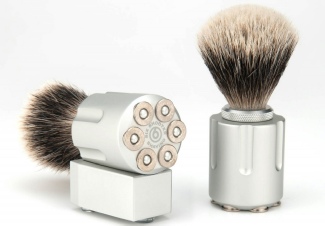
We pride our company on exceptional quality. Every Six Shooter Shave Brush is hand crafted in the USA. You will notice that we have tried to stay true to the “six shooter” even down to the authentic shell casings we use. Your morning shave will never be the same when you reach for your “Six Shooter”.
Each Set Contains:
Revolver Body – hand crafted from a solid piece of high grade anodized aluminum.
Removable Shave Brush – great for cleaning or replacement brush.
2 oz. Classic Shaving Cream -
Six Shooter Brush Stand -
Silvertip Badger – lush feeling on your face every morning.
Loft: 55mm
Knot: 24mm
Authentic Casings -
Laser Engraved -
Get your own. Only … $149.99.
Yep, I have discovered via the Internet that a subculture exists that I knew not of…men who obviously are more obsessed by shaving than I ever imagined possible!
From the fellows around me over the years…my husband, father, grandson, etc…I just assumed shaving every morning (for those not growing facial hair, or using an electric razor) was pretty close to the ritual of brushing and flossing your teeth. A necessary chore you got done and out of the way as quickly as possible. Throw-
While no doubt huge numbers of men do have the shave-
And what makes the shaves savorable seems to be the Shaving Brush.
A shave brush or shaving brush is a small brush with a handle parallel to the bristles used to apply shaving soap or shaving cream to the face when shaving. Shave brushes are often decorative; the handle is sometimes made from fine materials such as ivory or even gold, though the bristle load may be composed of any number of natural or synthetic materials. The shave brush is utilized most often today by "wet shavers" in tandem with a double-
The modern shaving brush may be traced to France during the 1750s. The French call a shaving brush blaireau or "badger." Quality of these brushes differed greatly, as materials used to fashion the handles varied from the common to the exotic. It was not uncommon for handles to be made of ivory, gold, silver, tortoise shell, crystal, or porcelain. The more expensive brushes used badger hair, with cheaper ones using boar's hair. In the 1800s when the folding-
I’d seen shaving brushes as props in old movies, but never really paid any attention to what they were for. I had to look it up…seems that you would put some bits of soft soap of some kind in the bottom of a little “shaving brush cup or mug,” wet your shaving brush, and then use it sort of like a cooking “whisk” that you use when making whipped cream to put on a pie—to “whip up” the soap into a fluffy foam to put on your face.
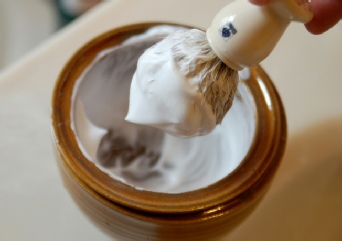
This would help soften the beard hairs and I guess “stand them up straighter” to be more efficiently scraped off without cutting your face. Shaving brush aficionados evidently take pride in the quality and look of their shaving cup or mug too.
The delicacy of porcelain makes the mug/bowl truly a stylish creation. The inverted hat shape of the Edwin Jagger Porcelain Shaving Bowl [$35] has attracted many wet shaving enthusiasts because of its soft curves available in black, ivory and white.
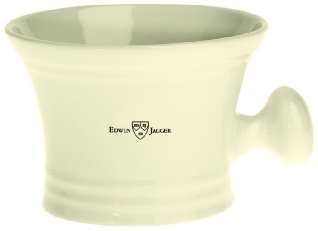
More than that, this smart design is known to keep the soap in place as well as preventing the brush from clacking. The somewhat vintage appearance finished with the EJ emblem combines the artistic with the highly practical.
But the big question of the day is…what kind of fiber to make the shaving brush out of. NO-
… Proponents of wet shaving claim that badger hair is the finest and most luxurious material possible. The water retention capacity, smooth sensation on the face, and durability are unmatched by other synthetic or natural materials.

Yes, it would appear the vast majority of brushes are made out of the fur of badgers. And depending on how much you are willing to pay, it turns out badgers produce three different levels of quality in hair.
Although there is not an industry standard that specifically defines grades of badger hair, there are basic classifications that many manufacturers use to describe the quality of hair used in their brushes.The most common gradations of badger hair are "pure" badger, "best" badger, and "super" or "silvertip" badger.
Pure badger is badger hair brushes that use the most common hair from the underbelly of a badger, the hair which covers around 60% of a badger's body. This hair varies greatly in softness, pliability and color. Pure badger hair is usually dark in color, but fluctuates from a light tan to a near-
… Silvertip badger is the most expensive and rare type of badger hair. The tips on this hair appear white naturally, without bleaching. A "flared" bristle load gives results in the 'silvertip' brush's fluffy appearance and lends the brush its ability to hold a large amount of water. Due to its water retention capacity, a 'silvertip' brush can create well-
So … how much are the most dedicated aficionados of the smooth face willing to pay for such a brush?
Brushes made of 'extra silvertip' with a high-
But wait … badgers are a protected species in Europe and North America. So where do the brush manufacturers get their badger hair?
…virtually all commercial badger hair comes from mainland China, which supplies knots of hair in various grades to brush makers in both China and Europe. In rural Northern China, badgers multiply to the point of becoming a crop nuisance, and village cooperatives are licensed by the national government to hunt badgers and sell the hair to processors. [Wiki: Shaving Brush]
I would guess the average high-
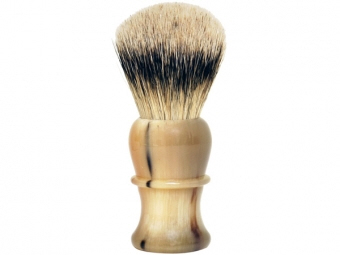
While rummaging around looking for brush prices, I came across the “Couturelite” website.
What is Couturelite?
A better question would be: 'What is a couturelitist?' We are the people that stay privy to the latest in luxury, fashion, travel, and all that matters.
We invite you to join our society. Call it our little secret...but we'd prefer that you run out and tell your friends about us. You savor the finer things life has to offer and we're sure you've asked yourself 'is this worth it'? Here, under no uncertain terms, you find out.
Here’s what a brush shave groupie commented on that website regarding purchasing a silver tip shave brush…
Not only is a wet shave the best kind of shave for a healthy appearance, but it gives me 4 to 6 minutes every morning to reflect on my day, without interruption, and that’s priceless. -
But it turns out that back almost 100 years ago, someone tried, quite successfully actually, to wean vast numbers of men away from their shaving brushes. In 1929 if you were driving down the highway across many parts of America, you would have seen several little red signs in a row beside the highway with white printing on them saying:
Your shaving brush
Has had its day
So why not
Shave the modern way
With / Burma-
Yes, the inventor of a new “brushless” shaving cream wanted to revolutionize the habits of American males.
Burma-
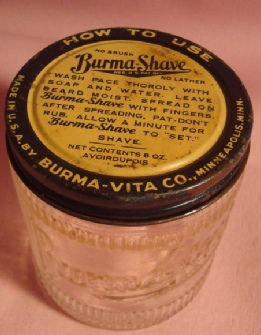
The company's original product was a liniment made of ingredients described as having come "from the Malay Peninsula and Burma.” Demand was sparse, and the company sought to expand sales by introducing a product with wider appeal.
The result was the Burma-
The earliest version of the cream was in glass jars, and evidently they were sturdy and attractive enough that some folks…especially during the Depression, I suppose…saved them.
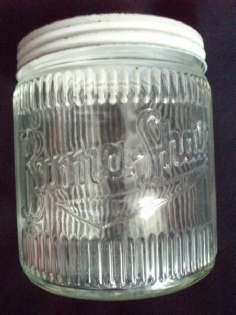
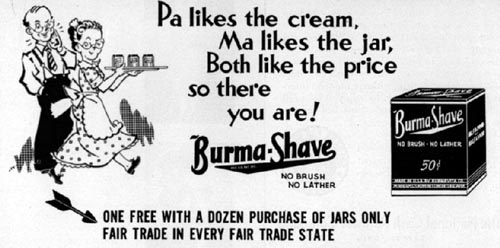
Sales declined in the 1950s, and in 1963 the company was sold to Philip Morris. The signs were removed at that time. The brand decreased in visibility and eventually became the property of the American Safety Razor Company.
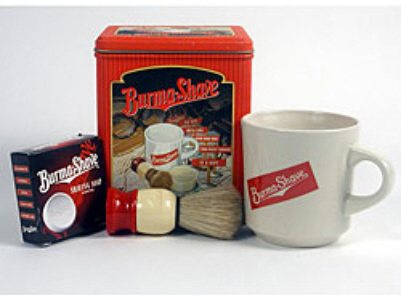
In 1997, the American Safety Razor Company reintroduced the Burma-
But even though the signs are gone, they live on in the memory of millions.
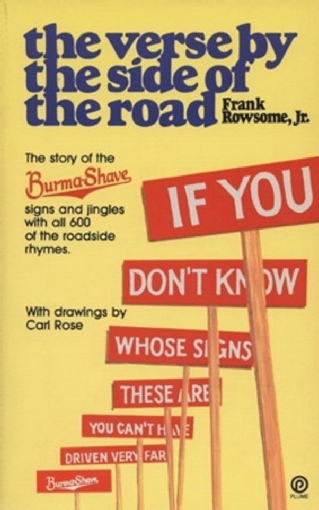
Burma-
This use of a series of small signs, each of which bore part of a commercial message, was a successful approach to highway advertising during the early years of highway travel, drawing the attention of passing motorists who were curious to learn the punchline. As the Interstate system expanded in the late 1950s and vehicle speeds increased, it became more difficult to attract motorists' attention with small signs. When the company was acquired by Phillip Morris, the signs were discontinued on advice of counse.
Some of the signs featured safety messages about speeding instead of advertisements.
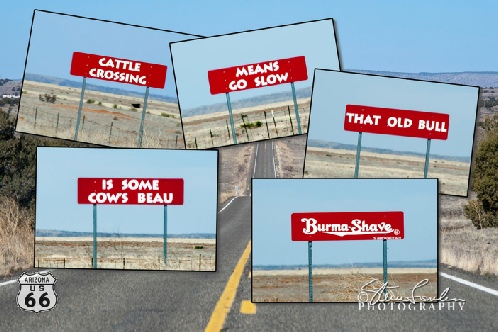
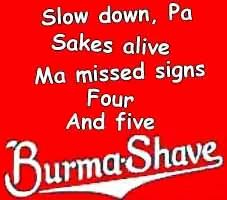
So here are a few more samples of the kind of doggerel that was on the signs.
In 1929, the prosaic ads began to be replaced by actual verses on four signs, with the fifth sign merely a filler for the sixth:
Every shaver / Now can snore / Six more minutes / Than before / By using / Burma-
Your shaving brush / Has had its day / So why not / Shave the modern way / With / Burma-
In 1935, the first known appearance of a road safety message appeared, combined with a punning sales pitch:
Train approaching / Whistle squealing / Stop / Avoid that run-
Keep well / To the right / Of the oncoming car / Get your close shaves / From the half pound jar / Burma-
Safety messages began to increase in 1939, as these examples show. (The first of the four is a parody of "Paul Revere's Ride" by Henry Wadsworth Longfellow.)
Hardly a driver / Is now alive / Who passed / On hills / At 75 / Burma-
Past / Schoolhouses / Take it slow / Let the little / Shavers grow / Burma-
If you dislike / Big traffic fines / Slow down / Till you / Can read these signs / Burma-
Don't take / a curve / at 60 per. / We hate to lose / a customer / Burma-
The war years found the company recycling a lot of their old signs, with new ones mostly focusing on World War II "propaganda":
Let's make Hitler / And Hirohito / Feel as bad / as Old Benito / Buy War Bonds / Burma-
Slap / The Jap / With / Iron / Scrap / Burma-
Even the print versions of Burma-
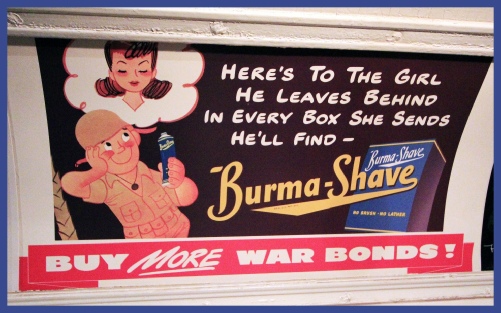
There are a few Burma-
There are some funny stories in the history of the Burma Shave Company. In Los Angeles, free sample jars were handed out to men as they entered a wrestling match. However, when one of the wrestlers angered the crowd, some of them started to throw their jars into the ring. Fortunately (and probably miraculously) no one was hurt . . . a close shave for the company, so to speak.
A similar occurrence happened at Ebbets Field in New York. Tubes of Burma Shave were handed out to fans entering the game, but when the umpire made a call unfavorable to the Dodgers, he was pelted with the tubes.
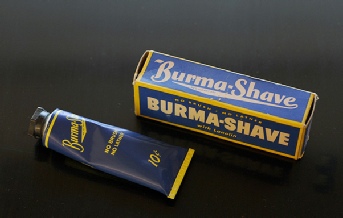
The game had to be interrupted until the groundskeepers could remove the tubes.
Another problem that arose was that the Burma Shave signs had a tendency to disappear near college towns. To remedy this, special bolts were used, so that a special tool was necessary to unbolt the signs, and the posts had crosspieces attached to the bottoms to act as anchors.
Another problem in rural areas was the tendency for hunters to use the signs for target practice. Some destruction was also caused by small animals that took to chewing on the signs. However, much more damage was attributed to horses that found them to be an ideal height for back scratching. A horse would maneuver itself beneath the bottom edge of a sign and then begin to scratch the itch. This would often result in a broken sign. This problem was solved when many of the signs were raised from nine feet to ten.
Still another problem occurred when the Burma Shave Company tried to mock the rising trend of coupon advertising with the following rhyme:
FREE OFFER! FREE OFFER!
RIP A FENDER
OFF YOUR CAR
MAIL IT IN FOR
A HALF-
BURMA-
Fenders began to arrive in the mail and by express, and local people scavenged the Minnesota junkyards and brought in fenders. Some fenders from toy cars also came in, and without exception, everyone who brought or sent in a fender received a free half-
Perhaps the company went too far with the following rhyme spoofing science fiction and curiosity about outer space:
FREE -
A TRIP
TO MARS
FOR 900
EMPTY JARS
BURMA-
[Arliss French]…manager of a supermarket in Appleton, Wisconsin, took up the challenge and wrote to the company asking where he should send the 900 jars for his free trip. The company sent back the following reply: “If a trip to Mars you’d earn, remember, friend, there’s no return.”
In reply, the enterprising supermarket manager accepted. He turned the project into a fantastic promotion for Burma Shave that had children and adults swarming the supermarket. The promotion included no less than a rocket plane on display and little green men on the roof firing toy rocket gliders into the parking lot.
And the project worked, as the little description from the Neatorama nostalgia website describes.
French managed the town's Red Owl supermarket and offered to pay customers 15 cents for every empty Burma Shave jar they brought in. He ran a full-
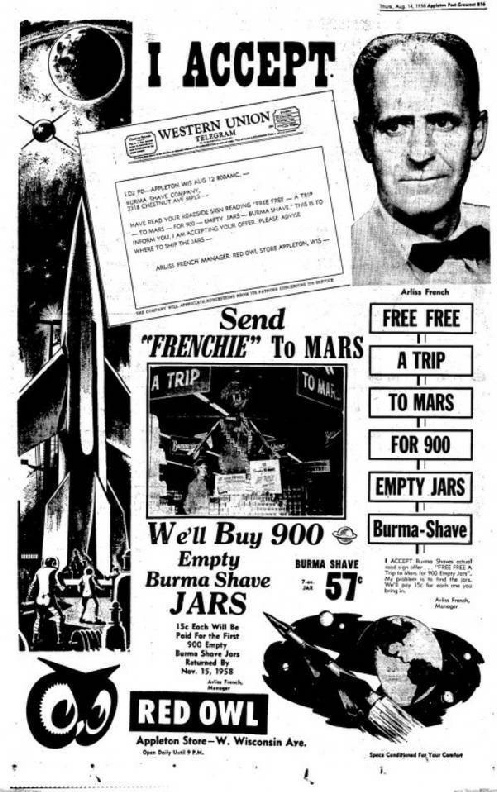
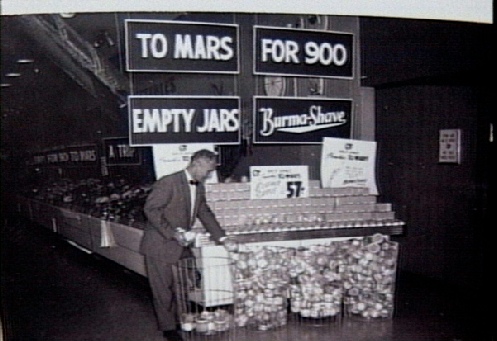
As the empties accumulated in his store, he telegraphed the company, "Please advise where to ship the jars."
The folks at Burma Shave scrambled to avoid embarrassment. Thinking he would decline, they offered to send him to the village of Moers, Germany (which they insisted was pronounced, "Mars") if he would wear a space suit for the trip. He agreed.
French and his wife departed New York at the company's expense on Dec. 2, 1958. He wore a football helmet and a silver costume emblazoned with the Red Owl logo. When he arrived in Moers two days later, all 78 residents turned out to greet him.
If you are glutton for PUNishment, you can read the whole collection of about 600 classic roadside jingles at Burma-
And in conclusion, here's the Spirit of Burma-

~~~~~
If you found this Burma Shave history interesting, you might enjoy Happy (Face) History.


Exploring our past to sort out myth from reality
Share this Page on
Facebook or Twitter

These are the voyages of the TimeShip Anachron.
Our Mission: To boldly explore the past, dispelling
mythinformation and mythconceptions
of American History along the way.
 Visit us on Facebook
Visit us on Facebook